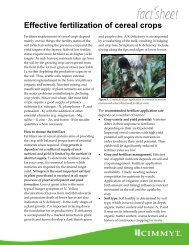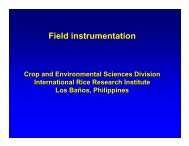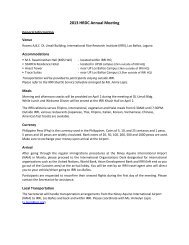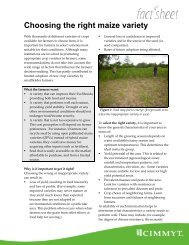Water management in irrigated rice - Rice Knowledge Bank ...
Water management in irrigated rice - Rice Knowledge Bank ...
Water management in irrigated rice - Rice Knowledge Bank ...
- No tags were found...
Create successful ePaper yourself
Turn your PDF publications into a flip-book with our unique Google optimized e-Paper software.
Table 3.5. <strong>Water</strong> <strong>in</strong>put (I = irrigation, R = ra<strong>in</strong>fall) and yield of aerobic <strong>rice</strong> variety HD297 under aerobic conditions <strong>in</strong> 2003and 2004, Beij<strong>in</strong>g, Ch<strong>in</strong>a. Data from Xue Changy<strong>in</strong>g et al (2007).2003 2004<strong>Water</strong> <strong>in</strong>put (mm) Yield (t ha −1 ) <strong>Water</strong> <strong>in</strong>put (mm) Yield (t ha −1 )I I + R Exp 1 Exp 2 I I + R408 688 4.25 3.11 535 705 5.58408 618 3.70 2.54 535 675 5.35408 648 2.11 1.26 535 645 5.35408 578 − 0.46 535 605 4.99Table 3.6. Performance of aerobic <strong>rice</strong> grown by farmers around Kaifeng, northern Ch<strong>in</strong>a, <strong>in</strong> terms of yield and water use,2002-03. Data from Bouman et al (2007).Farmer (code letter) A B C D E F GYield (t ha −1 ) 3.8 4.4 3.8 5.1 5.5 4.7 3.4Irrigation (mm) 225 225 80 231 230 300 225Ra<strong>in</strong>fall (mm) 337 337 337 337 337 337 337Total water <strong>in</strong>put (mm) 562 562 417 568 567 637 562Farmer (code letter) U V W X Y ZYield (t ha −1 ) 1.2 3.8 2.4 3.8 3.6 3.0Irrigation (mm) 156 159 145 169 146 162Ra<strong>in</strong>fall (mm) 674 674 674 674 674 674Total water <strong>in</strong>put (mm) 830 833 819 843 820 836Kaifeng <strong>in</strong> the North Ch<strong>in</strong>a Pla<strong>in</strong>, Feng Lip<strong>in</strong>g etal (2007) obta<strong>in</strong>ed relatively low yields of 2.4−3.6t ha −1 with 750−1,000 mm of total water <strong>in</strong>put. Itis estimated that aerobic <strong>rice</strong> systems are currentlybe<strong>in</strong>g pioneered by farmers on some 80,000 ha<strong>in</strong> northern Ch<strong>in</strong>a us<strong>in</strong>g supplementary irrigation(Wang Huaqi et al 2002). Bouman et al (2007)reported yields of aerobic <strong>rice</strong> obta<strong>in</strong>ed by farmersaround Kaifeng of up to 5.5 t ha −1 with sometimesas little as 566 mm of total water <strong>in</strong>put, with onlyone or two supplementary irrigation applications(Table 3.6). Table 3.7 compares the performance<strong>in</strong>dicators of aerobic <strong>rice</strong>, lowland <strong>rice</strong>, and maizeobta<strong>in</strong>ed by farmers <strong>in</strong> the same area. Simulationmodel predictions even suggested that no irrigationwould be needed for high yields with some 400−600mm of ra<strong>in</strong>fall and groundwater tables of 2 m deepand less. In Brazil, a breed<strong>in</strong>g program to improveupland <strong>rice</strong> has resulted <strong>in</strong> aerobic varieties with ayield potential of up to 6 t ha –1 (Piñheiro et al 2006).Farmers grow these varieties <strong>in</strong> rotation with cropssuch as soybean and fodder on large commercialfarms with supplemental spr<strong>in</strong>kler irrigation on anestimated 250,000 ha of flat lands <strong>in</strong> the Cerradoregion, realiz<strong>in</strong>g yields of 3−4 t ha −1 .The development of tropical aerobic <strong>rice</strong> is ofrelatively recent orig<strong>in</strong>. De Datta et al (1973) grewlowland variety IR20 <strong>in</strong> aerobic soil under furrowirrigation at IRRI <strong>in</strong> the Philipp<strong>in</strong>es. <strong>Water</strong> sav<strong>in</strong>gswere 55% compared with flooded conditions, butyield fell from about 8 t ha −1 under flooded conditionsto 3.4 t ha −1 under aerobic conditions. Us<strong>in</strong>gimproved upland <strong>rice</strong> varieties, George et al (2002)reported aerobic <strong>rice</strong> yields of 1.5−7.4 t ha −1 <strong>in</strong>uplands with 2,500 to 4,500 mm of annual ra<strong>in</strong>fall<strong>in</strong> the Philipp<strong>in</strong>es. Yields of 6 t ha −1 and more,however, were realized only <strong>in</strong>cidentally <strong>in</strong> the firstyears of cultivation, and most yields were <strong>in</strong> the 2−3t ha −1 range. Atl<strong>in</strong> et al (2006) reported aerobic <strong>rice</strong>yields of 3−4 t ha −1 us<strong>in</strong>g recently developed aerobic25


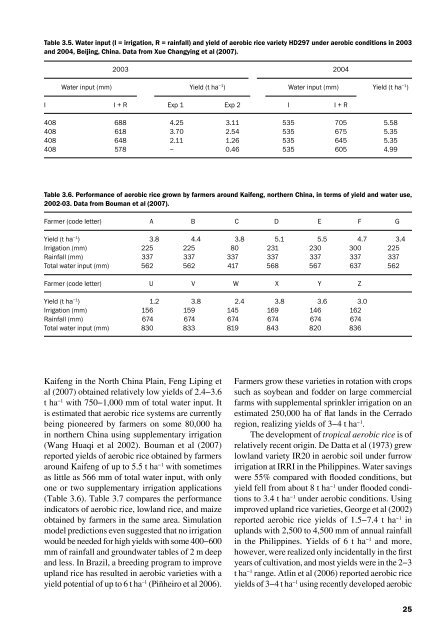


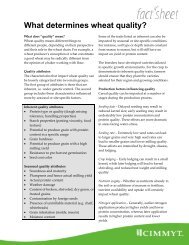

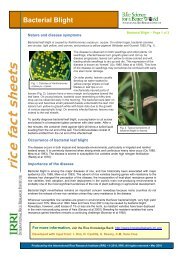

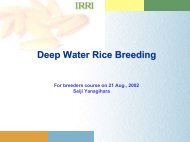
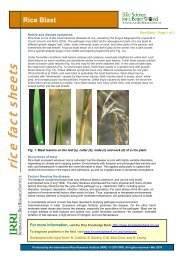
![International Standards' Organization â Rice Specification [ISO 7301]](https://img.yumpu.com/36696862/1/190x245/international-standards-organization-a-rice-specification-iso-7301.jpg?quality=85)

